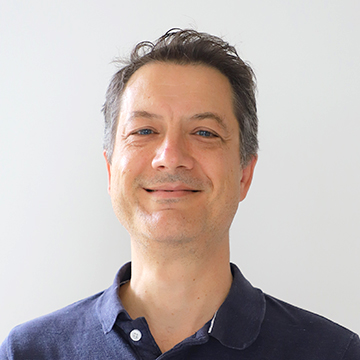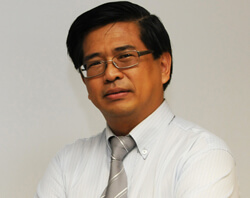 Dr. YAO Kui Distinguished Principal Scientist, Institute of Materials Research & Engineering (IMRE), A*STAR |
Plenary 1: Ferroelectrics and structural imperfections for multifunctional energy conversions and edge intelligence |
|---|
| Wednesday, 24 Sept, 9:00am, venue: LT 26 |
|
The development of edge computing and intelligence requires deployment of tremendous and distributed energy-autonomous smart sensors with local processing capabilities, while the existing sensors and electronics typically require external power supply and signal processing. With asymmetric lattice structure and highly responsive electrical polarization, ferroelectric materials possess multiple energy conversion and storage functions, such as piezoelectric, pyroelectric, bulk photovoltaic properties, high dielectric permittivity and switchable polarization. These multiple functions inherent in ferroelectrics may enable edge computing and intelligence in principle, but the signal or energy output from normal ferroelectrics is typically too small for practical energy-autonomous operation. Appropriately introducing various structural imperfections in ferroelectric materials is an effective strategic approach for significantly improving their response magnitude. These structural imperfections include coexistence of multiple phases, lattice defects, and various structural heterogeneities with energy competition. Relevant material systems are cited for discussing the underlying mechanisms and effectiveness. The feasibility for utilizing ferroelectric multiple functionalities with significantly enhanced response for realizing distributed sensors and in-situ intelligence is discussed. Work with Yasmin Mohamed Yousry, Shashidhara Acharya, and Chao Jiang. |
 Assoc. Prof. WU Lin, Singapore University of Technology and Design (SUTD) |
Plenary 2: Particle-in-Cell (PIC) Simulations for Next-Gen. Plasmonics & Optoelectronics | |||||||
|---|---|---|---|---|---|---|---|---|
| Wednesday, 24 Sept, 9:45am, venue: LT 26 | ||||||||
|
Computational simulations are redefining electromagnetism, especially in modeling quantum plasmas—materials where electron dynamics are fast, nonlinear, and strongly coupled to electromagnetic fields. Traditional methods like Finite-Difference Time-Domain (FDTD) and Finite Element Method (FEM) often fall short in these regimes, while the Particle-in-Cell (PIC) method excels by capturing self-consistent interactions between particles and fields [1-4]. Using PIC, we explore nonlinear electron transport in graphene antennas and plasmonic resonators, revealing unexpected even-order nonlinearities that enable frequency-tunable infrared upconversion [3]. Notably, we uncover a mechanism for second-harmonic generation driven by electron funneling in THz optical resonators, where ultrafast electron-surface scattering reduces the required field intensity by 3–4 orders of magnitude. Room-temperature metals and semimetals, acting as cold quantum plasmas, emerge as a promising platform for low-field, high-efficiency nanophotonic applications. PIC’s ability to model ultrafast, non-equilibrium carrier dynamics makes it a powerful tool for designing next-generation devices across plasmonics, optoelectronics, and photonics. | ||||||||
|
 Assoc. Prof. Massimo PICA CIAMARRA School of Physical and Mathematical Sciences (SPMS), Nanyang Technological University |
Plenary 3: What makes a glass solid? |
|---|---|
| Thursday, 25 Sept, 9:00 am, venue: LT 26 | |
|
Solid state textbooks describe at length the mechanical and transport properties of crystalline solids, while limit their discussion of non-crystalline solids, or glasses, to a minimum. This is not because glasses are unimportant—on the contrary, they are ubiquitous in technology and daily life, from optical fibers and display screens to metallic glasses and polymer-based materials. Rather, it reflects the fact that, despite glasses being used by humankind for millennia, we still lack a first-principles theory of their properties. In this talk, I will discuss recent results addressing the most fundamental question of all: why are glasses solid? |
 Visiting Research Assoc Prof. Maxime RICHARD, CNRS / Majulab |
Plenary 4: Quantum fluid of interacting photons |
|---|
| Thursday, 25 Sept, 9:45am, venue: LT 26 |
|
Tapping into years of expertise in semiconductor nanotechnology and optoelectronic properties engineering, we design and fabricate solid-state microcavities – i.e. light trap for visible light of a few cubic wavelengths volume - in which photons are subject to large interactions with each other. Upon driving such a system resonantly with coherent light, one obtains a few-photon steady-state that consists in many-body quantum fluctuations surrounding a classical mean field, which is the result of a non-trivial interplay between the interactions, and the quantum fluctuations of the environment that this open system is coupled to. In a series of experiments and theoretical development, we show that these fluctuations exhibit a rich panel of quantum states and properties. Depending on the experimental conditions, the system can exhibit the onset of quantum blockade, and hence sub-Poissonian photon emission statistics, or the fluctuations can turn into the photonic counterpart of Bogoliubov states, exhibiting strong photons pairing and time-ordering quantum correlations. |
 Prof. Dale BARKER, Meterological Serivce Singapore, and Director of the Centre for Climate Research Singapore |
Plenary 5: The Challenge of Understanding, Modelling and Predicting the Unique Weather and Climate of the Singapore Region |
|---|
| Friday, 26 Sept, 9:00 am, venue: LT 29 |
|
Situated approximately one degree north of the equator, Singapore has a unique deep-tropical urban climate that provides a challenging testbed for research, weather prediction and improved understanding of the impact of climate change in coming years and decades. The tropical climate system is highly complex, requiring expertise in a wide range of physical processes e.g. turbulence/convective processes, the Greenhouse effect, cloud microphysics, frictional impacts of different land surfaces, etc. Traditional weather/climate models apply the Navier Stokes equations tailored to include both resolved and parameterized physical processes, optimized for both research and operations on some of the world’s larger supercomputers. AI is making a huge impact on traditional weather/climate science, complementing understanding of the physical climate system as we prepare for today’s weather and future climate change. This talk will provide an overview of the physical climate system, as well as CCRS’ approach to weather/climate modelling, weather prediction and projections of future climate. |
 Assoc. Prof. CHUNG Keng Yeow Department of Physics, NUS, and Director of the NUS Singapore Nuclear Research and Safety Institute. |
Plenary 6: Nuclear Safety Research in Singapore |
|---|---|
| Friday, 26 Sept, 9:45 am, venue: LT 29 | |
|
The speaker will give a brief introduction to the nuclear power in the world and the recent development in nuclear reactor technologies. He will also touch on the study of the potential deployment of nuclear power in Singapore and explain how the research at the Singapore Nuclear Research and Safety Institute (SNRSI) supported this effort. The different research areas of SNRSI, namely Reactor Safety, Radionuclide Dispersion, Radiochemistry, Radiobiology and Nuclear Policy will also be presented with emphasis on those areas related to Physics. |
 IPS Meeting - Plenary sessions
IPS Meeting - Plenary sessions